
Annona sericea is a species of plant in the family Annonaceae. It is native to Bolivia, Brazil, Colombia, French Guiana, Guyana, Suriname, Trinidad-Tobago and Venezuela. Michel Félix Dunal, the French botanist who first formally described the species, named it after the silky hairs on its branches and leaves. In Brazil its common name is Aratincum do Para.
Annona acutiflora is a species of plant in the Annonaceae family. It is native to Brazil. Carl Friedrich Philipp von Martius, the German botanist who first formally described the species, named it after the inner petals which come to a sharp point.

Annona jahnii is a species of plant in the family Annonaceae. It is native to the Brazil, Colombia and Venezuela. William Edwin Safford, the American botanist who first formally described the species, named it after the Venezuelan scientist, explorer and mountain climber Alfredo Jahn.

Annona paludosa is a species of plant in the family Annonaceae. It is native to Brazil, French Guiana, Guyana, Suriname and Venezuela. Jean Baptiste Christophore Fusée Aublet, the French pharmacist and botanist who first formally described the species, named it after its swampy habitat.

Cremastosperma cauliflorum is a species of plant in the family Annonaceae. It is native to Brazil, Colombia, Ecuador and Peru. Robert Elias Fries, the Swedish botanist who first formally described the species, named it after its flowers which grow from its main trunk or stem.
Fusaea decurrens is a species of plant in the family Annonaceae. It is native to Peru. Robert Elias Fries. The Swedish botanist who first formally described the species, named it after wings of the leaves that run down the stem of the leaf.
Goniothalamus latestigma is a species of plant in the family Annonaceae. It is native to Myanmar and Thailand. Cecil Ernest Claude Fischer, the botanist who first formally described the species, named it after its broad stigmas.
Goniothalamus puncticulifolius is a species of plant in the family Annonaceae. It is native to Borneo and The Philippines. Elmer Drew Merrill, the American botanist who first formally described the species, named it after its minutely spotted leaves.
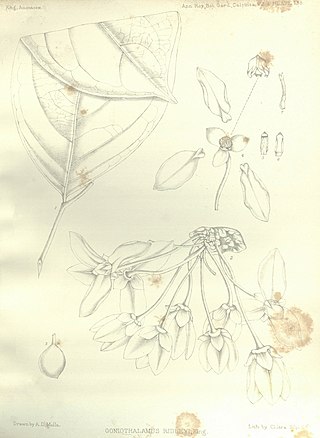
Goniothalamus ridleyi is a species of plant in the family Annonaceae. It is native to Borneo, Peninsular Malaysia, Sumatra and Thailand. George King, who first formally described the species, named it after the English botanist Henry Nicholas Ridley who collected the specimen King examined.
Goniothalamus sawtehii is a species of plant in the family Annonaceae. It is native to Myanmar and Thailand. Cecil Ernest Claude Fischer the botanists who first formally described the species, named it in honor of Maung Saw Teh, a plant collector who provided the specimen examined by Fischer.

Mitrephora heyneana is a species of plant in the family Annonaceae. It is native to India and Sri Lanka. Joseph Dalton Hooker and Thomas Thomson, the British botanists who first formally described the species under the basionym Orophea heyneana, named it after Benjamin Heyne a German botanist who collected and described many plant species from India.

Mitrephora keithii is a species of plant in the family Annonaceae. It is native to Myanmar, Peninsular Malaysia and Thailand. Henry Nicholas Ridley, the English botanist who first formally described the species, named it in honor of Dr. A. Keith who collected the sample that Ridley examined.
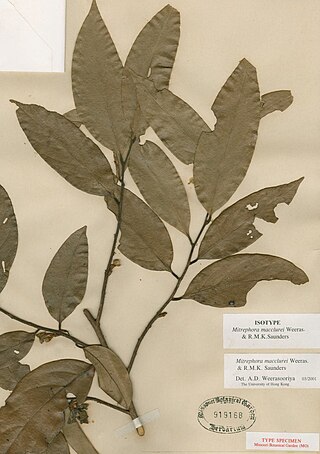
Mitrephora macclurei is a species of plant in the family Annonaceae. It is native to China, Laos and Vietnam. Aruna Weerasooriya and Richard Saunders, the botanists who first formally described the species, named it after Floyd Alonzo McClure of Lingnan University, who collected the holotype specimen that they examined.
Mitrephora macrocarpa is a species of plant in the family Annonaceae. It is native to Sulawesi. Friedrich Anton Wilhelm Miquel, the Dutch botanist who first formally described the species using the basionym Orophea macrocarpa, named it after its large fruit.
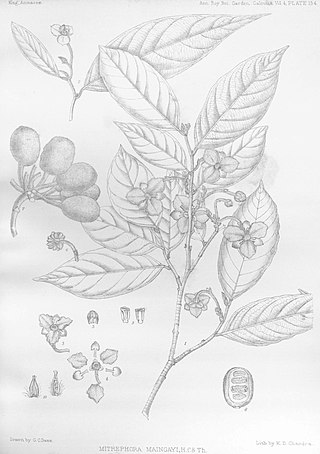
Mitrephora maingayi is a species of plant in the family Annonaceae. It is native to Bangladesh, Borneo, Cambodia, Laos, Peninsular Malaysia, Myanmar, Sumatra, and Vietnam. Joseph Hooker and Thomas Thomson, the British botanists who first formally described the species, named it in honor of Alexander Carroll Maingay, the British botanist who collected the specimen they examined.
Duckeanthus is a genus of plant in the family Annonaceae. It is native to Brazil. It contains a single species, Duckeanthus grandiflorus. Robert Elias Fries, the Swedish botanist who first formally described it, named it in honor of Adolpho Ducke who collected the specimen he examined, and its large flowers.
Pseuduvaria clemensiae is a species of plant in the family Annonaceae. It is native to New Guinea. Yvonne Chuan Fang Su and Richard M.K. Saunders, the botanists who first formally described the species, named it after Mary Strong Clemens who collected the specimen they examined.
Pseuduvaria mollis is a species of plant in the family Annonaceae. It is native to New Guinea. Otto Warburg, the German-Jewish botanists who first formally described the species using the basionym Goniothalamus mollis, named it after the soft hairs on its leaves and petals.
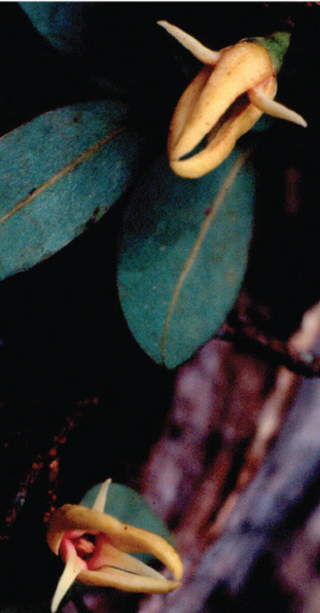
Xylopia arenaria is a species of plant in the Annonaceae family. It is native to Kenya, and Tanzania. Adolf Engler, the botanist who first formally described the species, named it after its growth in sandy places.
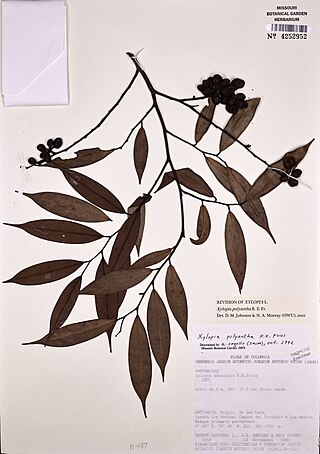
Xylopia polyantha is a species of plant in the Annonaceae family. It is native to Bolivia, Brazil, Colombia, Ecuador, and Peru. Robert Elias Fries, the botanist who first formally described the species, named it after its many flowers.











